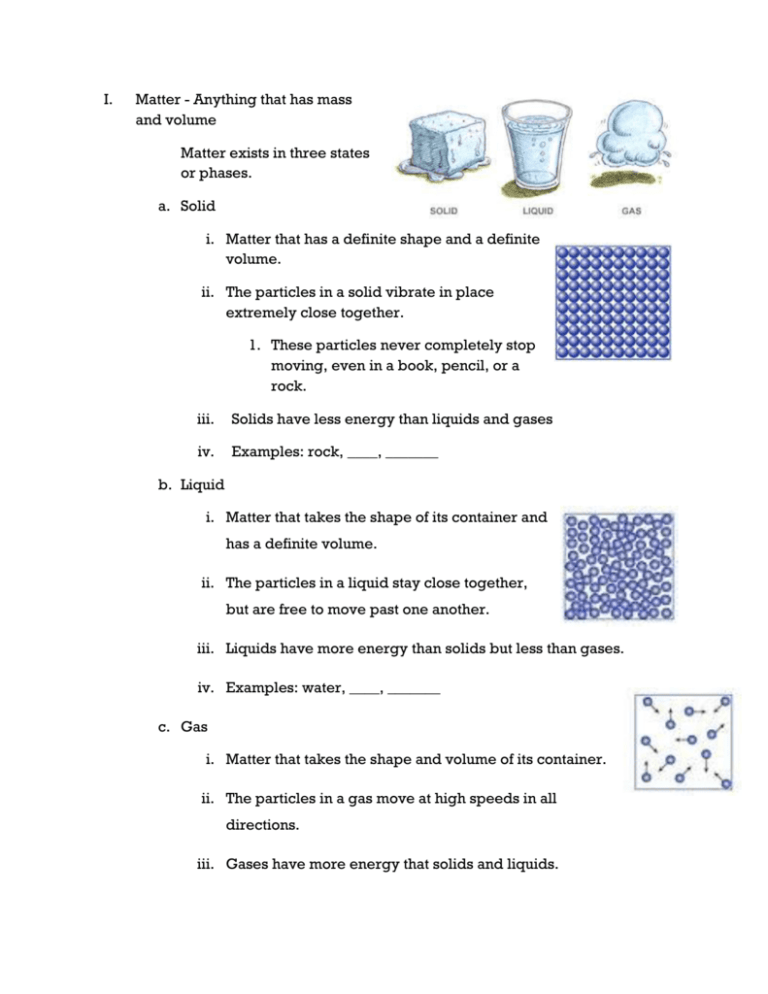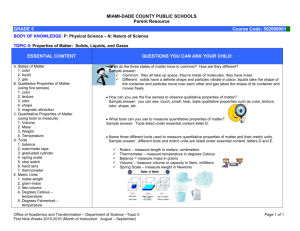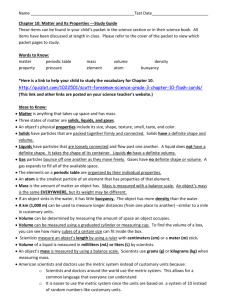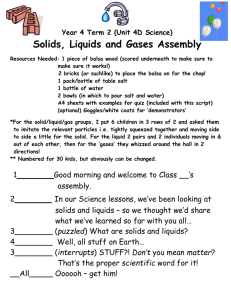I. Matter - Anything that has mass and volume Matter exists in three
advertisement

I. Matter - Anything that has mass and volume Matter exists in three states or phases. a. Solid i. Matter that has a definite shape and a definite volume. ii. The particles in a solid vibrate in place extremely close together. 1. These particles never completely stop moving, even in a book, pencil, or a rock. iii. Solids have less energy than liquids and gases iv. Examples: rock, ____, _______ b. Liquid i. Matter that takes the shape of its container and has a definite volume. ii. The particles in a liquid stay close together, but are free to move past one another. iii. Liquids have more energy than solids but less than gases. iv. Examples: water, ____, _______ c. Gas i. Matter that takes the shape and volume of its container. ii. The particles in a gas move at high speeds in all directions. iii. Gases have more energy that solids and liquids. iv. Examples: helium, ____, _______ II. Measurement (two systems) a. Metric system of measurement i. Also known as SI System (System International) ii. Prefixes can be used with any base unit, a standard system that is good for mathematical conversions, but is more difficult to estimate. b. English System of measurement i. Grew out of the creative way people measured for themselves such as feet, paces (1000 paces is a mile), cup, and galloon (gallon comes from the word pail, such as a bucket). A system of measurement that is good for estimating, but has difficult mathematical conversions. c. Basic Units: Quantity Length Volume Mass Temperature Time Metric unit Meter – m Liter – L Gram – g o Celsius - oC Seconds - s English unit(s) Foot Gallon slug Fahrenheit oF Seconds - s Symbol T G M k h da Value 1,000,000,000,000 1,000,000,000 1,000,000 1,000 100 10 d. Prefixes: Prefix Tera Giga Mega Kilo Hecto Deca Base (no prefix) 1 Deci d Centi c Milli m Micro µ Nano n Pico p Kids hate doing boring dumb crazy metrics! 0.1 0.01 0.001 0.000,001 0.000,000,001 0.000,000,000,001 __________ __________ __________ __________ __________ __________ __________ Practice prefixes: • Kilometer • Liter • Milliliter • Decagram • Centiliter • Deciliter • Hectogram • Milligram III. Measurement a. Length is the measurement of distance between objects or points i. Basic metric unit is the meter ii. measured with a ruler, meter stick b. Volume – is the amount of space an object takes up i. There are several methods and tools to measure volume of solids and liquids. Volume can be determined using length x width x height ii. Basic metric unit is the liter iii. A cubic centimeter (cc) is used for solids and is equal to a milliliter (mL) used for liquids. 1. 1cc = 1mL iv. Measuring Volume for liquids - use a graduated cylinder, measure at the meniscus (the bottom of the curve) 1. A graduated cylinder is the most accurate but you can also use a beaker, flask, and measuring cups and spoons. 2. Practice measuring: v. Measuring Volume for rectangular shaped objects 1. Practice: vi. Measuring Volume for irregular shaped objects. 1. For this method we use a graduated cylinder 2. This method is called water displacement 1. Volume Before _________ 2. Volume After _________ 3. Total Volume of Object ______________ c. Mass is the amount of matter in a substance i. All matter has mass, whether it’s a solid, liquid, or gas. ii. Water, air, and your pencil all have mass. iii. measured with a triple beam balance iv. Basic metric unit is the gram v. 1ml of H2O has a mass of 1 g vi. ****Mass will be a critical factor in many of the experiments we complete this year. It will be used many times to mathematically calculate scientific data. Mass is NEVER to be thought of as weight! vii. Mass determines an important concept called inertia 1. Inertia - the tendency of an object to resist a change in its motion. d. Temperature – is the measurement of the average kinetic energy of the particles in a substance i. Measured with a thermometer ii. Basic metric unit is oCelsius e. Density is how close together the molecules of a substance are or how much mass a substance has in a given space. i. If you have one cup of jelly beans and one cup of marshmallows, the jelly beans have more mass, there is more “stuff” compacted into the same amount of space, therefore will have a higher density. While both made with sugar, the marshmallows are mostly air. ii. Density is used to compare objects which are different iii. Definition: Density is the amount of mass per unit of volume of an object. iv. Determined as mass divided by volume (m/v) v. The density of H2O is 1g/ml vi. Objects with a density less than 1g/ml (or 1 g/cc) will float, while objects with a density greater than 1g/ml will sink f. Conduction is a property of matter. i. Conductor – a material, such as copper or silver, through which electrons can move easily and electricity passes. 1. Examples: ________________________________________ ii. Insulator – material, such as wood or glass, through which electrons cannot move easily and electricity or heat is not conducted 1. Examples: ________________________________________ IV. Scientific Method / Experiments a. There are five steps to the scientific method: i. Problem/Question – what we are trying to solve through experimentation. ii. Hypothesis – a testable statement to a problem. 1. The hypothesis should either be a positive statement (Salt water boils at a higher temperature than fresh water) or a negative statement (Plants will not grow in the dark). 2. The hypothesis should address the IV and the DV iii. Procedure – the process you do to complete the experiment iv. Analyze data – review observations and measurements v. Conclusion 1. Determine whether the data supports the hypothesis. 2. Develop an explanation for why the results occurred. a. Use ACE i. ii. iii. Answer the question Cite evidence from the data Explanation – connect the data to the answer of the question b. Controlled Experiments i. The experiments we do this year will be controlled experiments. This means we will carefully control things in an experiment called variables. ii. A variable is any anything in an experiment that can change or be changed; any factor that can have an effect on the outcome of the experiment. iii. There are three kinds of variables in any experiment. 1. Independent Variable – the variable that is changed by the scientist during the procedure. To ensure a fair test, a good experiment only has one independent variable. Known as the “I” change it variable since “I” am the scientist and Independent starts with “I” 2. Dependent Variable – the variable is the result that is observed and measured in response to the independent variable. (“D” for determined or discovered) 3. Controlled variable – any factor that could change but is intentionally kept constant or the same. (“C” for constant)





